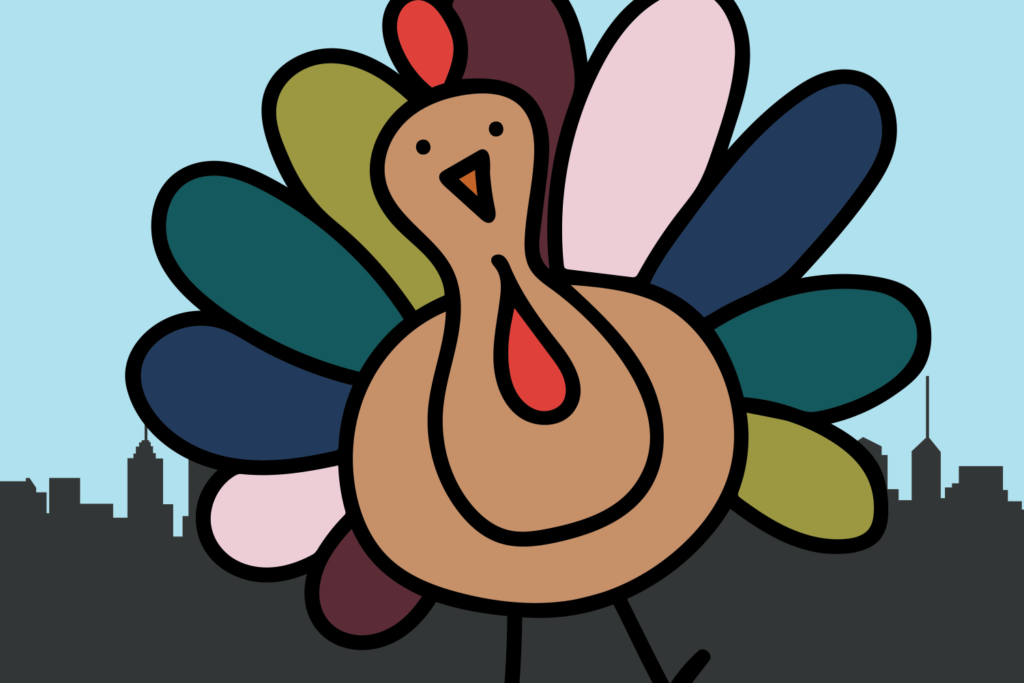Like an action hero ratcheting up the tension for his climactic stunt, the turkey scouts out the gap, preparing to leap across it. A fall for a human might break a bone or two. But this turkey bends its legs, flaps its wings, and lands. It’s amazing that a bird weighing up to 30 pounds can fly.
It’s one of many stories documented on the @turkeysofumn Instagram page. Run by sophomores Amanda Ichel and Paige Robinson, the account posts a constant stream of turkey-related mayhem.
Inspired by @turkeys_of_uw_madison (a similar turkey-themed account for the University of Wisconsin-Madison), Robinson asked Ichel to join. Ichel, who is afraid of birds, accepted and has loved turkeys ever since. Now with more than 3,000 followers, @turkeysofumn and the campus turkeys have become a neighborhood landmark.
Why has the turkey taken campus culture by storm? Maybe it’s because the bird’s head can change color to red, white, and blue in a matter of seconds, but it’s not the bird’s innate patriotism that’s captivating students.
Let’s take a look back at the origins of campus turkey.
Turkeys have never been as beloved as they are today: In the 1970s, Minnesota sold ruffed grouse to Missouri in exchange for wild turkeys, according to David Andersen, a professor of bird studies at the University of Minnesota. The birds were released into southeastern Minnesota, where they slowly became established.
“There’s not much historical evidence, at least not much, that there were turkeys in Minnesota,” Andersen said.
When turkeys started showing up on campus, Sally Knoll, a professor who specializes in turkey nutrition, got a lot of calls asking if the farmed turkeys were gone. Of course, the farmed turkeys hadn’t fled; a new bird had arrived on campus: the wild turkey.
For senior Robert Griskey, seeing a turkey on campus is still a shock: He follows @turkeysofumn because “the novelty of seeing a turkey keeps me coming back for more.”
It’s not just students who are paying attention to the account: Official university accounts from the Carlson School of Business, Boynton Health, and the alumni association have also taken notice and commented on the posts. Ichel recalls that her professor, who taught neuroanatomy to a class of 200 students, sent her a Canvas message on Thanksgiving congratulating her and @turkeysofumn for being featured in the New York Times; the account had been featured in a Thanksgiving article.
Posting turkey content exposed Robinson and Ichel to a culture of quirkiness that’s deeply rooted in Minnesota, but they don’t consider themselves part of campus culture.
“We’re not part of the campus culture, instead we promote turkey culture and provide an outlet for people who care about turkeys,” Robinson said.
People have flocked to the account: A popular video has been viewed nearly 4,000 times and shows the turkeys scouring and pecking at windows at Ridder Arena.
“My guess is that the bird sees its own reflection in the glass, thinks there’s another turkey there, and it’s used to being in charge, so that annoys it,” Anderson says. “It’s probably trying to annoy the turkey in its reflection.”
Encounters like these have given turkeys their mythical status: “They’re like mystical, god-like creatures that roam campuses,” Ghriskey says.
The creation of mythical statues is at the core of Turkish culture.
It’s funny to anthropomorphize a turkey with supernatural abilities that plot destruction.
St. Paul’s turkey has an epic name: Mega. After spotting it on Instagram, sophomore Taylor Booth named it Meg (short for Megalodon), and it can now be seen around McNeil Hall.
Turkeys are also depicted as messengers of peace, with one caption reading, “Turkeys are the one thing that can bring people together in these times.” That may sound corny and dramatic, but for Robinson and Ichel, it’s absolutely true.
“If it weren’t for the turkey account, we wouldn’t be talking right now,” Robinson said.
“That’s why we were friends,” Ichel added.


